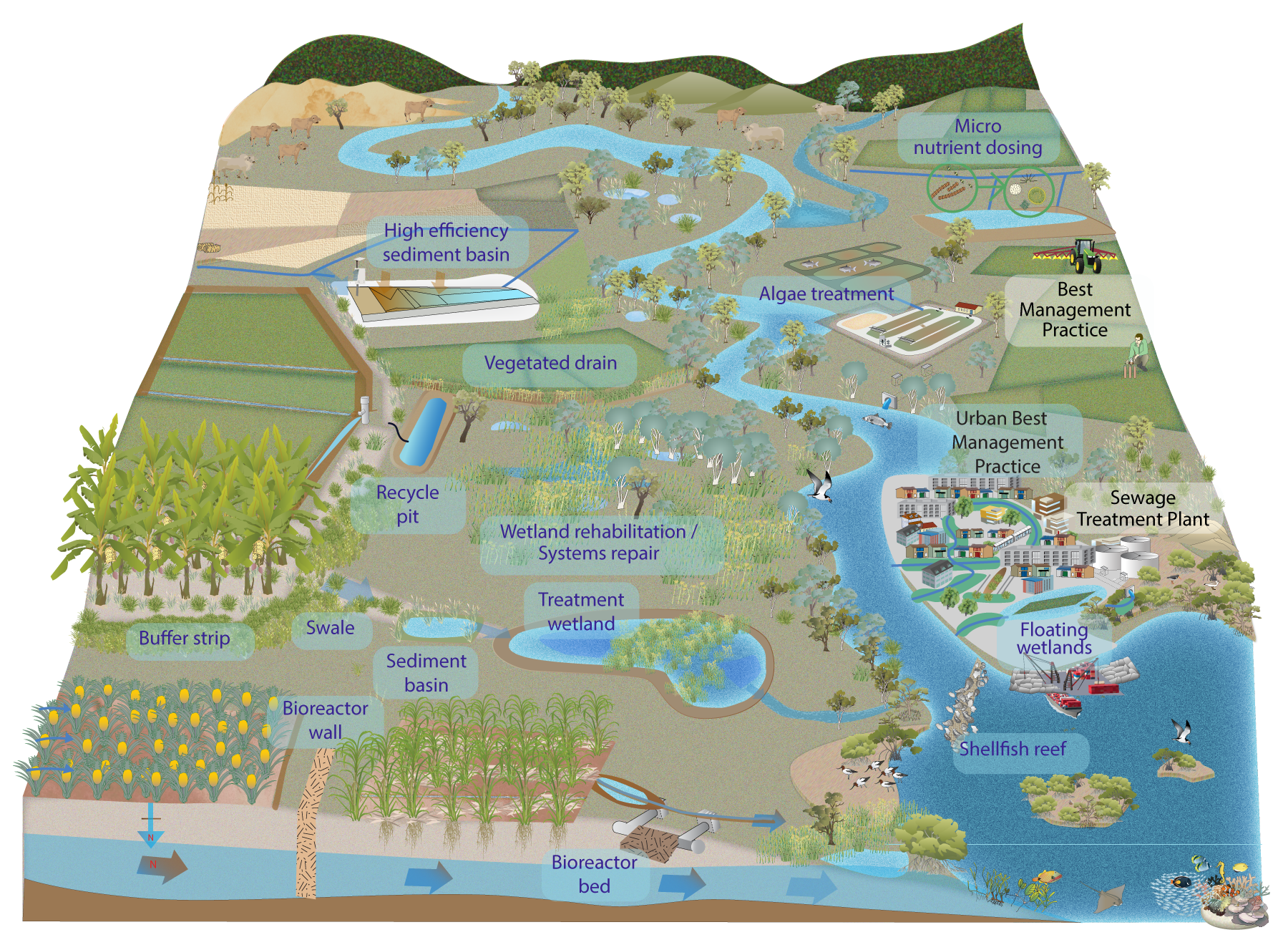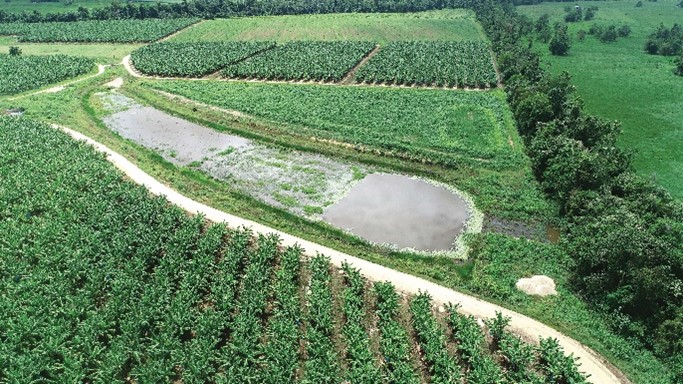|
|
Treatment systemsTreatment systems for improving water quality are engineered and designed to intercept, slow down and remove pollutants from water. Treatment systems are an engineered system which may be a suitable management option when the main goal or objective is water quality improvement. Pollutants such as sediments, nutrients and other toxicants (pesticides, heavy metals etc.) from urban, industrial and agricultural land uses, can enter wetlands and coastal or marine environments. Improving water quality from catchment land uses, is essential to maintain or improve the health and resilience of these ecosystems. Treatment systems, when used in conjunction with best practice land management, can improve water quality and in turn aquatic ecosystem health on a catchment scale.

Click on treatment systems in the diagram above for detailed information on each treatment system. Refer to Table 1 below for a comparison of different treatment systems.
Treatment systems are designed to use natural wetland hydrologic, physical, biological or chemical processes and components (parts of the system e.g. soil, vegetation etc.) to remove specific pollutants from water (Table 1). No single treatment system is efficient in treating all pollutants. That is why multiple treatment systems are often combined to form a treatment train. Treatment systems complement, but do not replace the need for measures to prevent the loss of pollutants from the source, such as erosion control (e.g. pile fields, ground cover) or to implement nutrient, sediment, chemical and water best management practices. They should be considered as part of a whole of system approach to catchment management and are thus one option under aquatic ecosystem rehabilitation. Best management practices are the essential first step in any treatment train to prevent or minimise pollutants. The treatment system or treatment train must be designed for the quantity and quality of water entering the treatment system. Loads of sediments, nutrients or other toxicants above the design criteria will overload, and often, damage treatment systems, causing them to stop working effectively and potentially lead to costly maintenance and repair. Likewise, directing relatively clean water, such as runoff from undeveloped land, away from treatment systems leads to a more effective treatment system by ensuring that only the water requiring treatment enters the treatment system. Click for more information on - Treatment systems for agriculture (including aquaculture) focuses on systems to treat pollutants in food and fibre production systems; Urban stormwater treatment and water sensitive urban design (WSUD) focuses on systems to treat pollutants in urban environments; Other intensive land use treatments focuses on systems to treat pollutants from industrial activities, sewage treatment and other intensive uses. Treatment systems can be used at a range of scales from house block or paddock scale, through to regional scale systems treating runoff from multiple properties or a sub-catchment. The type, design and operation of a treatment system and treatment train depends on several factors including:
Treatment system effectivenessTreatment systems are designed for pollutant removal, although they can provide other services or benefits (Table 1). If the objective of the system is to provide habitat or other ecosystem services, also read about aquatic ecosystem rehabilitation. Table 1 Treatment processes, effectiveness and relative complexity of different treatment systems for water quality improvement.
1Confidence is based on peer-reviewed publications on trials in Queensland in a variety of settings. This also indicates confidence in the design requirements to maximise treatment performance. 2Other biotic characteristics include habitat for insects, small fish, birds and threatened species[2]. Note: refer to cost considerations for more information on the potential costs of different treatment systems. Treatment system modellingHydrological models can be used to assist in the choice and design of treatment systems. Water modelling is the process of developing mathematical and logic-based representations of real-world relationships between different variables[4]. A range of numerical models are available to simulate the sediment and nutrient removal performance of wetlands and other treatment systems[4][3]. It is important to select a suitable model for the intended purpose and adjust the model parameters appropriately for the location[3][1]. Hydrological and water quality data is required to calibrate and validate any model. This may be available from public sources or site-specific monitoring may be required to enable a model to be developed[4]. Expert advice is generally required to choose and construct a hydrological model. The Queensland Water Modelling Network (QWMN) provides tools, information and collaborative platforms to support best-practice use of water models. DisclaimerIn addition to the standard disclaimer located at the bottom of the page, please note the content presented is based on published knowledge of treatment systems. Many of the treatment systems described have not been trialled in different regions or land uses in Queensland. If you have any additional information on treatment systems or suggestions for additional technologies contact us via the feedback link at the bottom of the page. Additional informationBeyond the Block factsheets – Improving water quality at the edge of block Using denitrifying bioreactors to improve water quality on Queensland farms Melbourne Water—options for treating stormwater Minnesota Pollution Control Agency—Processes for removing pollutants from stormwater runoff A model for urban stormwater improvement conceptualization. Global Solutions for Urban Drainage Bakers Creek Treatment Train - drone footage Pages under this sectionReferences
Last updated: 27 June 2022 This page should be cited as: Department of Environment, Science and Innovation, Queensland (2022) Treatment systems, WetlandInfo website, accessed 18 March 2024. Available at: https://wetlandinfo.des.qld.gov.au/wetlands/management/treatment-systems/ |
|||||||||||||||||||||||||||||||||||||||||||||||||||||||||||||||||||||||||||||||||||||||||||||

 — Department of Environment, Science and Innovation
— Department of Environment, Science and Innovation


